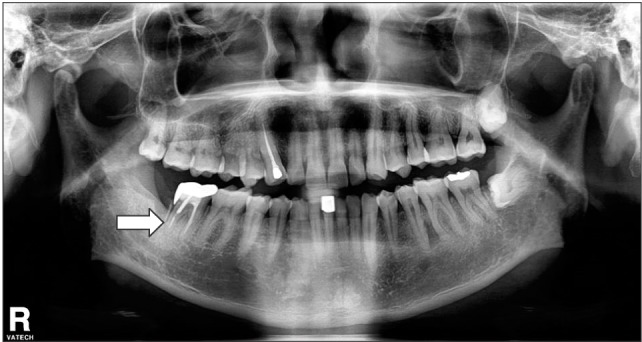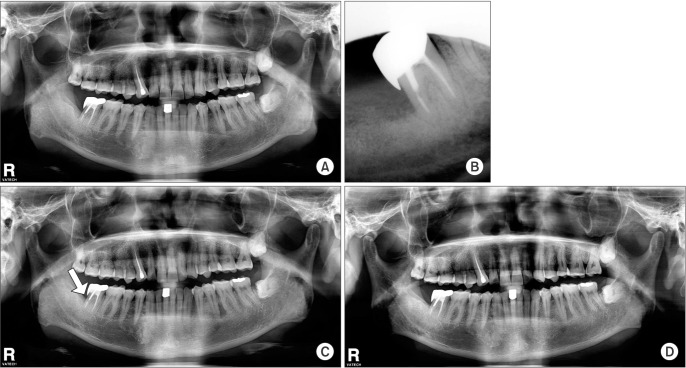J Korean Assoc Oral Maxillofac Surg.
2016 Aug;42(4):205-208. 10.5125/jkaoms.2016.42.4.205.
The treatment of actinomycosis mimicking a retained root tip: a confusing case
- Affiliations
-
- 1Department of Dentistry, Dongsan Medical Center, Keimyung University School of Medicine, Daegu, Korea. vice01@hanmail.net
- KMID: 2350072
- DOI: http://doi.org/10.5125/jkaoms.2016.42.4.205
Abstract
- Actinomycosis is an infection caused by the actinomyces genus and is associated with trauma or previous infection. A 58-year-old male patient was referred from a private dental clinic for root extraction of the lower right molar. The x-ray showed fractured root-like material distal to the distal root of the lower right second molar. A biopsy during extraction of the root-like material was performed, which revealed a sequestrum with actinomycosis by a pathological examination. In this case, the radiopacity of the suspicious lesion was higher than that of the surrounding alveolar bone, which confused it with the root tip. The diagnosis of actinomycosis required long-term antimicrobial therapy, which is very different from simple extraction or removal of sequestrum.
Keyword
MeSH Terms
Figure
Reference
-
1. Finley AM, Beeson MS. Actinomycosis osteomylelitis of the mandible. Am J Emerg Med. 2010; 28:118.e1–118.e4. PMID: 20006231.
Article2. Sharkawy AA. Cervicofacial actinomycosis and mandibular osteomyelitis. Infect Dis Clin North Am. 2007; 21:543–556. viiiPMID: 17561082.
Article3. Brook I. Actinomycosis: diagnosis and management. South Med J. 2008; 101:1019–1023. PMID: 18791528.
Article4. Smith MH, Harms PW, Newton DW, Lebar B, Edwards SP, Aronoff DM. Mandibular Actinomyces osteomyelitis complicating florid cemento-osseous dysplasia: case report. BMC Oral Health. 2011; 11:21. PMID: 21777471.
Article5. Kim NR, Park JB, Ko Y. Differential diagnosis and treatment of periodontitis-mimicking actinomycosis. J Periodontal Implant Sci. 2012; 42:256–260. PMID: 23346471.
Article6. Rankow RM, Abraham DM. Actinomycosis: masquerader in the head and neck. Ann Otol Rhinol Laryngol. 1978; 87:230–237. PMID: 646293.
Article7. Bennhoff DF. Actinomycosis: diagnostic and therapeutic considerations and a review of 32 cases. Laryngoscope. 1984; 94:1198–1217. PMID: 6381942.8. Kaplan I, Anavi K, Anavi Y, Calderon S, Schwartz-Arad D, Teicher S, et al. The clinical spectrum of Actinomyces-associated lesions of the oral mucosa and jawbones: correlations with histomorphometric analysis. Oral Surg Oral Med Oral Pathol Oral Radiol Endod. 2009; 108:738–746. PMID: 19748292.
Article9. Won HR, Park JH, Kim KS. Simultaneous actinomycosis with aspergillosis in maxillary sinus. Br J Oral Maxillofac Surg. 2013; 51:e51–e53. PMID: 22445647.
Article10. Figueiredo LM, Trindade SC, Sarmento VA, de Oliveira TF, Muniz WR, Valente RO. Actinomycotic osteomyelitis of the mandible: an unusual case. Oral Maxillofac Surg. 2013; 17:299–302. PMID: 23239430.
Article11. Marx RE, Sawatari Y, Fortin M, Broumand V. Bisphosphonate-induced exposed bone (osteonecrosis/osteopetrosis) of the jaws: risk factors, recognition, prevention, and treatment. J Oral Maxillofac Surg. 2005; 63:1567–1575. PMID: 16243172.
Article12. Choi J, Koh WJ, Kim TS, Lee KS, Han J, Kim H, et al. Optimal duration of IV and oral antibiotics in the treatment of thoracic actinomycosis. Chest. 2005; 128:2211–2217. PMID: 16236876.
Article13. Sun CX, Henkin JM, Ririe C, Javadi E. Implant failure associated with actinomycosis in a medically compromised patient. J Oral Implantol. 2013; 39:206–209. PMID: 21767210.
Article14. Sakallioğlu U, Açikgöz G, Kirtiloğlu T, Karagöz F. Rare lesions of the oral cavity: case report of an actinomycotic lesion limited to the gingiva. J Oral Sci. 2003; 45:39–42. PMID: 12816363.
- Full Text Links
- Actions
-
Cited
- CITED
-
- Close
- Share
- Similar articles
-
- Maxillary removable partial overdenture within Locator Root Attachment in a retained root: a case report
- Differential diagnosis and treatment of periodontitis-mimicking actinomycosis
- Hepatic Actinomycosis Mimicking a Malignant Tumor: Three Case Reports
- A Case of Abdominal Actinomycosis Mimicking Colon Carcinoma
- A Case of Actinomycosis of the Neck






